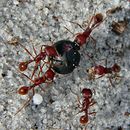Annals of the Entomological Society of America (2022) 115, 127-140
From Pestinfo-Wiki
 | Selected publication you are invited to contribute to the discussion section (above tab) |
From pests to keystone species: Ecosystem influences and human perceptions of harvester ants (Pogonomyrmex, Veromessor, and Messor spp.)
Annals of the Entomological Society of America 115 (2), 127-140
Abstract: Harvester ants (Latreille) (Formicidae: Hymenoptera) have traditionally been labeled as pests within their native ranges from perceived effects on crop production and rangeland productivity. Yet, modern research casts doubt on many of these perceived detrimental effects and instead suggests that harvester ants act as keystone species that largely benefit both ecosystems and human activities. Through nest engineering and trophic interactions (such as seed harvesting and predation), harvester ants have considerable direct and indirect effects on community structure and ecosystem functioning. Here we summarize the ecological roles of harvester ants and review their services and disservices to ecosystems and human activities. In doing so, we help clarify perceived keystone and pest roles of harvester ants and their implications for rangeland management. We find the numerous keystone roles of harvester ants to be well-supported compared to perceived pest roles. We also highlight areas where further research into their roles in natural and managed systems is needed.
(The abstract is excluded from the Creative Commons licence and has been copied with permission by the publisher.)
Full text of article
Database assignments for author(s): Richard Hofstetter
Research topic(s) for pests/diseases/weeds:
environment - cropping system/rotation
Pest and/or beneficial records:
| Beneficial | Pest/Disease/Weed | Crop/Product | Country | Quarant. |
|---|---|---|---|---|
| Pogonomyrmex barbatus | U.S.A. (mid S) | |||
| Pogonomyrmex occidentalis | ||||
| Messor barbarus | Spain (continental) |